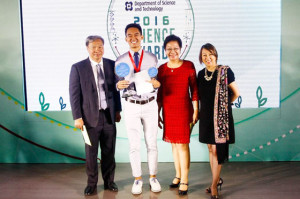WHEN disastrous Typhoon Nona (international name: Melor) crossed over the central Philippines in December last year, several provinces were paralyzed for days because of power outages.
With maximum sustained winds of 175 kilometers per hour, Nona toppled several power transmission lines and electric posts that added to the P1.836-billion worth of damages in infrastructure.
Clearly, the destruction caused more than inconvenience to affected residents. But this was nothing new in the Philippines, a nation battered by an average of 20 typhoons per year.
Twenty-five-year-old Jerome Alan Japitana, a fourth year BS Chemistry student of the University of Santo Tomas (UST), understands this very well.
In a bid to bring sustainable light to Filipinos affected by indefinite power outages whenever strong typhoons strike, Japitana developed new materials for an alternative source of renewable energy.
Japitana embarked on a research project titled “Using non-precious materials in the development of a cost-effective cathode catalyst for direct ethanol fuel cells.” He studied the use of cobalt to improve the efficiency of fuel cell performance. Fuel cells are a viable option for an environmentally-sustainable and economically-feasible source of energy.
“The study focuses on overcoming one of the main limitations of the fuel cell technology, specifically the cathode reaction,” Japitana explained. “By developing a catalyst for this reaction that is less expensive and yet more efficient, it is possible to open doors to a sustainable and economically viable alternative energy source,” he added.
One of the applications Japitana sees for his research in the future is the development of a light-emitting diode (LED) lamp that can be used during calamities and emergencies. His project was recognized by the Department of Science and Technology (DOST) and Bank of the Philippines Islands (BPI) Foundation, Inc. as this year’s Best Project and Best in Basic Research in the recently concluded 2016 BPI-DOST Science Awards.
The plum adds to UST’s already thriving Chemistry program, which was recently identified by the Commission on Higher Education (CHEd) as a Center of Excellence. BPI also mentioned UST as having the highest quality of research in terms of the number of times the published research article is cited.
“I believe this achievement can serve as an impetus for Thomasian researchers to further excel in providing scientific solutions to social issues both nationally and internationally,” Japitana said.
Raised in the US, Japitana hopes that his feat will open more opportunities for him to pursue his research further “to help alleviate the hardships of our Filipino brothers in [vulnerable areas].”
Apart from Japitana, other researchers included in the 2016 BPI-DOST Science Awards’ top six were Joselv Albano of Ateneo de Davao University (Best in Applied Research), Michelle Kho of Saint Louis University, John Andrew Kane Jovellana of University of the Philippines-Diliman, John Paul Penuliar of University of the Philippines-Los Baños and Jason Mactal also of UST.


